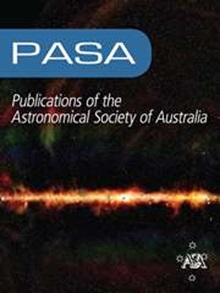Survey-scale discovery-based research processes: Evaluating a bespoke visualisation environment for astronomical survey data
IF 4.6
3区 物理与天体物理
Q1 ASTRONOMY & ASTROPHYSICS
Publications of the Astronomical Society of Australia
Pub Date : 2023-07-05
DOI:10.1017/pasa.2023.37
引用次数: 0
Abstract
Abstract Next-generation astronomical surveys naturally pose challenges for human-centred visualisation and analysis workflows that currently rely on the use of standard desktop display environments. While a significant fraction of the data preparation and analysis will be taken care of by automated pipelines, crucial steps of knowledge discovery can still only be achieved through various level of human interpretation. As the number of sources in a survey grows, there is need to both modify and simplify repetitive visualisation processes that need to be completed for each source. As tasks such as per-source quality control, candidate rejection, and morphological classification all share a single instruction, multiple data (SIMD) work pattern, they are amenable to a parallel solution. Selecting extragalactic neutral hydrogen (Hi) surveys as a representative example, we use system performance benchmarking and the visual data and reasoning methodology from the field of information visualisation to evaluate a bespoke comparative visualisation environment: the encube visual analytics framework deployed on the 83 Megapixel Swinburne Discovery Wall. Through benchmarking using spectral cube data from existing Hi surveys, we are able to perform interactive comparative visualisation via texture-based volume rendering of 180 three-dimensional (3D) data cubes at a time. The time to load a configuration of spectral cubes scale linearly with the number of voxels, with independent samples of 180 cubes (8.4 Gigavoxels or 34 Gigabytes) each loading in under 5 min. We show that parallel comparative inspection is a productive and time-saving technique which can reduce the time taken to complete SIMD-style visual tasks currently performed at the desktop by at least two orders of magnitude, potentially rendering some labour-intensive desktop-based workflows obsolete.基于巡天规模发现的研究过程:评估天文巡天数据的定制可视化环境
下一代天文调查自然会对当前依赖于使用标准桌面显示环境的以人为中心的可视化和分析工作流程提出挑战。虽然数据准备和分析的很大一部分将由自动化管道来处理,但知识发现的关键步骤仍然只能通过不同级别的人类解释来实现。随着调查中数据源数量的增加,需要修改和简化需要为每个数据源完成的重复可视化过程。由于每个源的质量控制、候选拒绝和形态分类等任务都共享一个单一指令、多数据(SIMD)工作模式,因此它们适合并行解决方案。选择银河系外中性氢(Hi)调查作为一个代表性的例子,我们使用系统性能基准测试和来自信息可视化领域的视觉数据和推理方法来评估一个定制的比较可视化环境:部署在8300万像素Swinburne Discovery Wall上的encube视觉分析框架。通过使用现有Hi调查的光谱立方体数据进行基准测试,我们能够通过一次对180个三维(3D)数据立方体进行基于纹理的体渲染来进行交互式比较可视化。加载光谱立方体配置的时间与体素数量呈线性关系,每次加载180个立方体(8.4千兆像素或34千兆字节)的独立样本在5分钟内完成。我们表明,并行比较检查是一种高效且节省时间的技术,可以将目前在桌面上执行的simd风格视觉任务所需的时间减少至少两个数量级,可能会使一些劳动密集型的基于桌面的工作流程过时。
本文章由计算机程序翻译,如有差异,请以英文原文为准。
求助全文
约1分钟内获得全文
求助全文
来源期刊
CiteScore
5.90
自引率
9.50%
发文量
41
审稿时长
>12 weeks
期刊介绍:
Publications of the Astronomical Society of Australia (PASA) publishes new and significant research in astronomy and astrophysics. PASA covers a wide range of topics within astronomy, including multi-wavelength observations, theoretical modelling, computational astronomy and visualisation. PASA also maintains its heritage of publishing results on southern hemisphere astronomy and on astronomy with Australian facilities.
PASA publishes research papers, review papers and special series on topical issues, making use of expert international reviewers and an experienced Editorial Board. As an electronic-only journal, PASA publishes paper by paper, ensuring a rapid publication rate. There are no page charges. PASA''s Editorial Board approve a certain number of papers per year to be published Open Access without a publication fee.

 求助内容:
求助内容: 应助结果提醒方式:
应助结果提醒方式:


